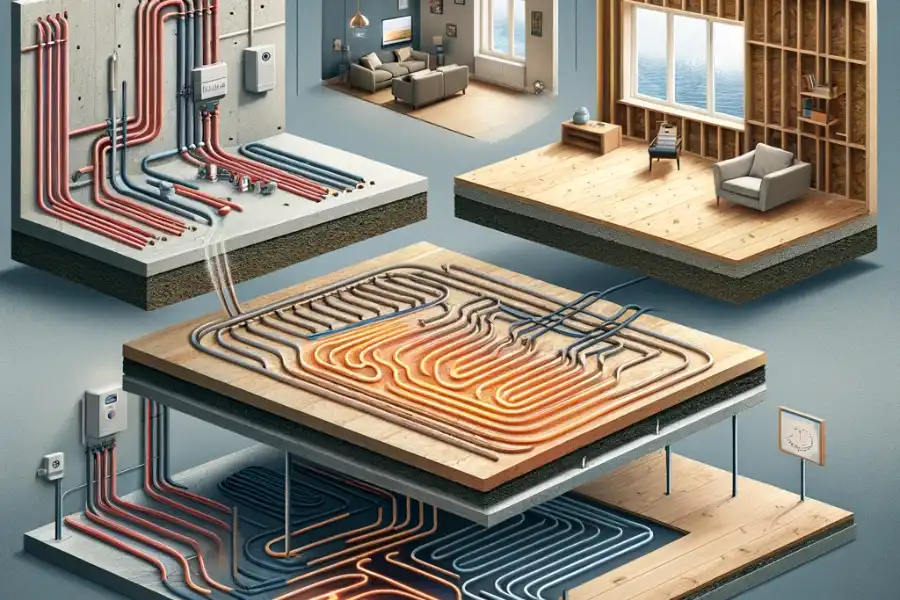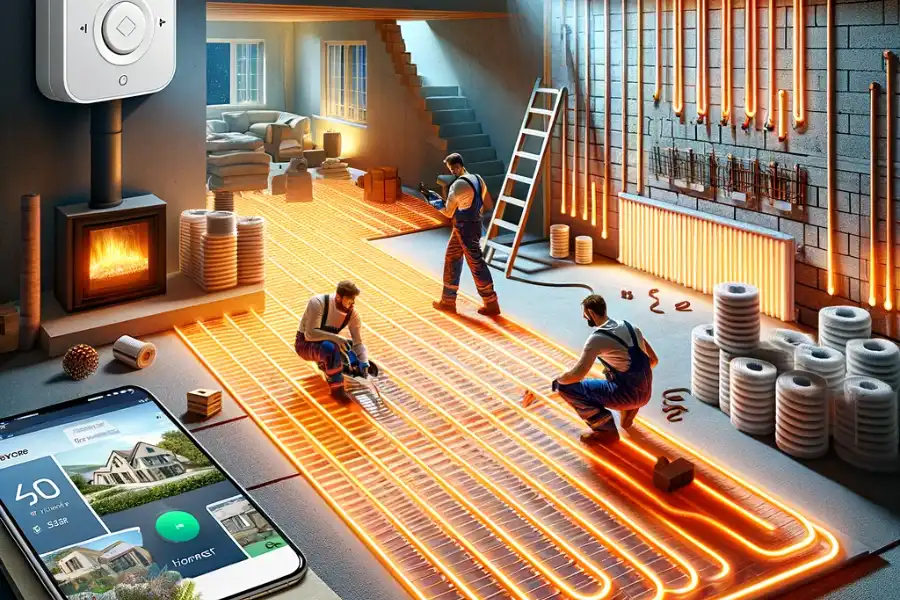
While underfloor heating can be easily installed in homes of virtually any shape or dimensions, experts argue that the best way to go about it is to install new build heating systems – i.e. to install your underfloor heating (UFH) system at the design phase.
But does underfloor heating add value to your new build? What is the best heating system for a new build? Can they help reduce energy bills? We answer that and more in this article.
Table of Contents
How to choose the best heating system for new builds
So, what is the best heating system for a new build?
Before we answer that, we need to understand that new build heating systems utilising underfloor heating are the absolute best choice for any new build project.
There are multiple options you can choose from where systems which have been specifically designed to integrate seamlessly with new builds. However, the kind of system you end up choosing depends on a few factors, two of which include:
- The property’s size – Pumped screed is ideal for larger homes instead of sand and cement. This is simply because it’s a lot faster to lay. So, the kind of screed you use will govern what kind of UFH system you can have installed, although options are available to suit both kinds of screed.
- Time limitations – Some screeds may require long drying times.
Upstairs installation – Additionally, UFH systems can be installed upstairs in a new build project. Let’s say you have a timber frame build, you can definitely get the 1st floor deck down and then install the UFH from below, right in between the joists.

What are the benefits of New Build Heating Systems (UFH)?
Installing an underfloor heating system in a new build project is often simpler compared to retrofitting a heater within, say, a renovation project. Why? Because you can easily note down the dimensions and needs of the system during the initial design phase. This means you can decide on the ideal subfloor construction along with the correct zoning area layout for your desired heater, while also ensuring that the ceiling heights will not be impacted by it.
Furthermore, underfloor heating offers you better design freedom with new builds. For instance, your architectural vision can expand without being affected by the installation of bulky radiators or unsightly heating pipes, which are typically the case with central heating systems.
Customised Underfloor Heating Systems
. Whether you’re building new or upgrading, our kits offer the perfect blend of modern heating technology and energy savings.
UFH systems are also a more energy-efficient option while still heating your space just as well as a traditional central heater. The radiant heat technology in it allows you to operate at lower temperatures as you still enjoy the same level of warmth and comfort you are accustomed to.
The reduced energy consumption means that you could potentially save up to £370 or more each year when using a quality underfloor heating system, including an electric underfloor heating system and water underfloor heating system.
But does underfloor heating add value to your new build? This is a question that has fascinated many homeowners and builders for quite some time and the answer is: yes!
Underfloor heating is ultimately more efficient than traditional heating systems, adding to a property’s design, aesthetic appeal, future-proofing and energy efficiency – thus, improving its market value.

Underfloor heating: Are there considerations for area and system type?
Yes, there are.
For example, if your domestic project has large open-plan spaces or your commercial project features multiple stories and several individual rooms, a hydronic system is the way to go.
Hydronic floor heaters make use of existing pipes, even those running up to 500 metres in length, so this means you can effectively utilise them in all projects, irrespective of their scale. Just make sure that your heating pipes are covered under an extensive warranty.
Now, if you want the UFH system installed in a smaller area or, say, a single room only, then an electric floor heater might be a better choice. Electric systems are very quick to install and offer a comparatively lower-profile heating system compared to water systems.
One more area of consideration you may want to explore when installing an underfloor heating solution in your new build is the assessment of the space for any potential loss of heat.

What about subfloor type and compatibility of heater?
The type of subfloor construction your new build has can influence the kind of floor heater you end up installing. However, since concrete subfloors are rather common in new build projects, they are beyond ideal for use with an underfloor heating system.
You may install the heating system directly into your concrete subfloor through ‘wet’ floor heating, where you can install a variety of water systems depending on your requirements, along with, preferably, an ‘Inscreed Cable’ electric system. Alternatively, you may also go for a ‘dry’ installation when having your electric and water system installed. These do not require any screeding whatsoever.
In some instances, where there are suspended timber subfloors in your project, for example, it might be best to install a custom system built and designed especially for such an application.

Is underfloor heating hard to install in new builds?
Underfloor heating is ideal for new constructions although it should be considered during the design phase in order to reap the most benefits, which include:
- Super-easy to install.
- Highly energy efficient and potential reduction in energy bills by up to £370 or more.
- Suitable for all kinds of floor structures.
- Helps you save space as there’s no need to install heating radiators.
Underfloor heating systems are extremely easy to use too:
- Our line of underfloor heating (UFH) systems come with user-friendly warm water underfloor heating kits.
- Smart thermostat integration allows for quick and easy remote control, even from your smartphone or mobile device.
- Zonal heating controls allow you to heat specific areas as and when required, thus, reducing energy waste.
- Radiant heat spreads across to create a more even and consistent temperature, as it is far more efficient than the convection-based heating traditional radiators provide.
While our underfloor heating systems add value to new builds, they also come with a variety of aesthetic and economic benefits, including:
- Fully concealed underfloor boards to help free up space and reduce visual clutter.
- Add significant value to new builds by integrating the latest, cutting-edge technology and energy efficiency.
- Improved interior design outcomes as there are no visible radiators.
- Smart thermostats that are programmable to achieve the most efficient heating management.

So Does Underfloor Heating Add Value?
Suffice it to say, we’ve answered that question in a transparent and insightful way, along with highlighting some of the key options you have available when it comes to new build heating systems.
You now also know the best heating system for a new build according to your own personal set of requirements and likely understand that the best and most efficient way to heat a new build property in 2024 and beyond is through underfloor heating systems – particularly if you choose water-based UFH systems as they run at lower temperatures while providing more efficient heat distribution.
Are you considering moving into a new build home? Here are the pros and cons to consider.
FAQs
Is underfloor heating worth it in a new build?
Yes, underfloor heating is often considered worth it in new builds due to its energy efficiency, space-saving benefits, and the even distribution of heat.
What is the most efficient way to heat a new build?
The most efficient way to heat a new build typically includes underfloor heating systems, particularly water-based systems, due to their lower operating temperatures and efficient heat distribution.
Is underfloor heating expensive to run?
The expense of running underfloor heating largely depends on the system type (electric or water-based) and the property’s insulation. Generally, water-based systems are more efficient and cost-effective in the long term, especially in well-insulated new builds.
What is the building regulation for underfloor heating?
Building regulations for underfloor heating often require adherence to specific installation standards, including insulation, maximum floor surface temperatures, and efficiency requirements. It’s important to consult local building codes for precise regulations.
Sources
HomeOwners Alliance. (n.d.) Pros and cons of new build homes. [online] Available at: https://hoa.org.uk/advice/guides-for-homeowners/i-am-buying/new-build-vs-existing-home/
